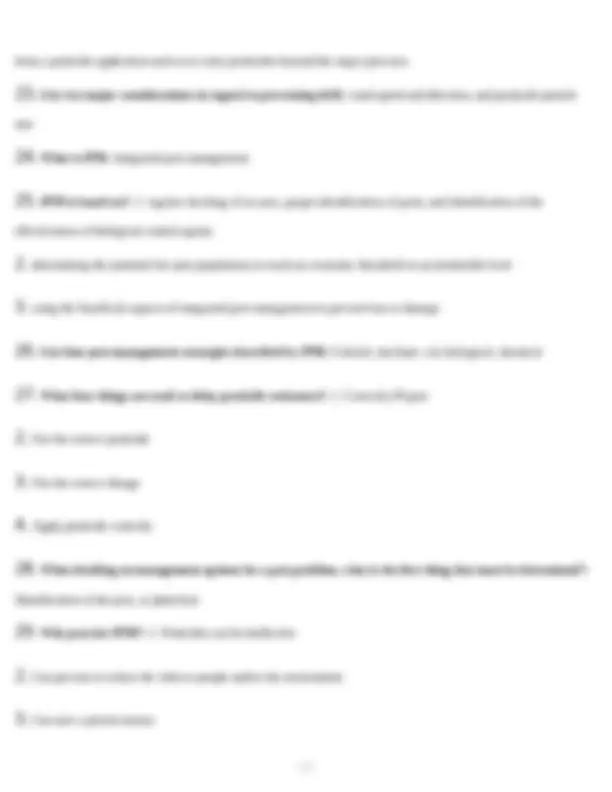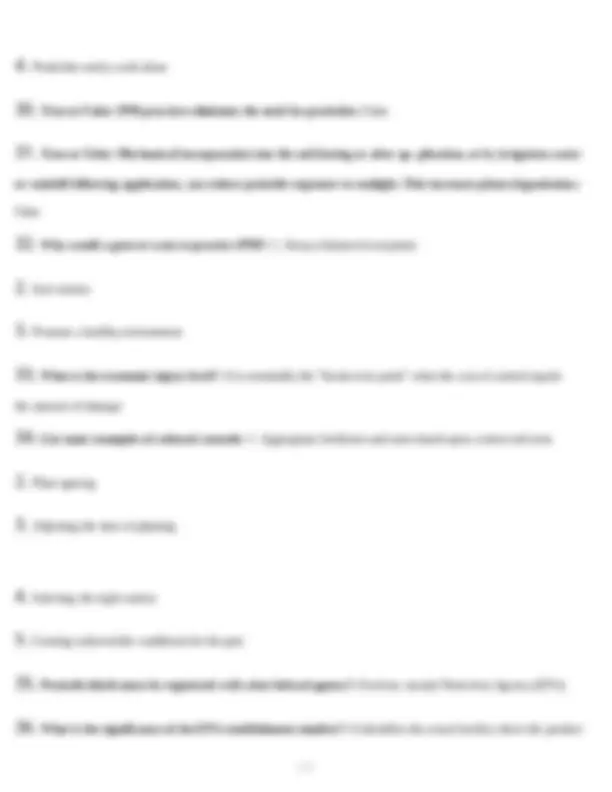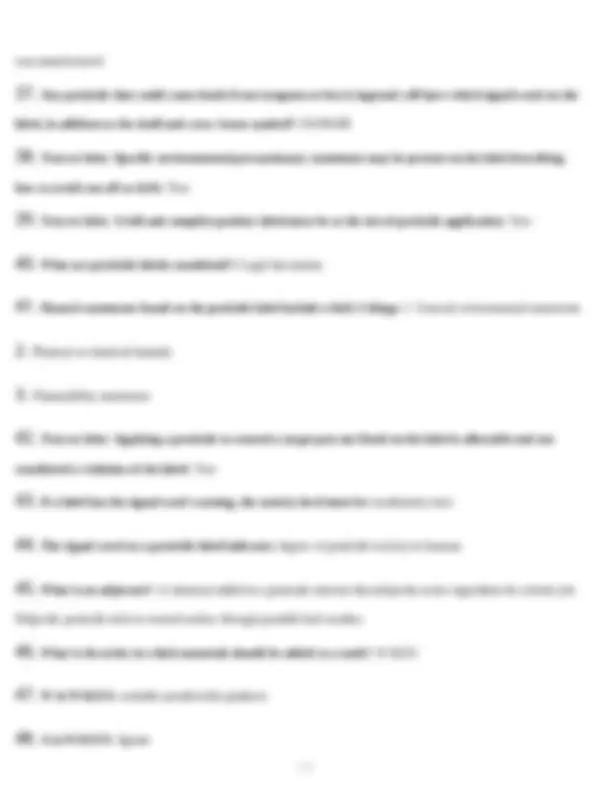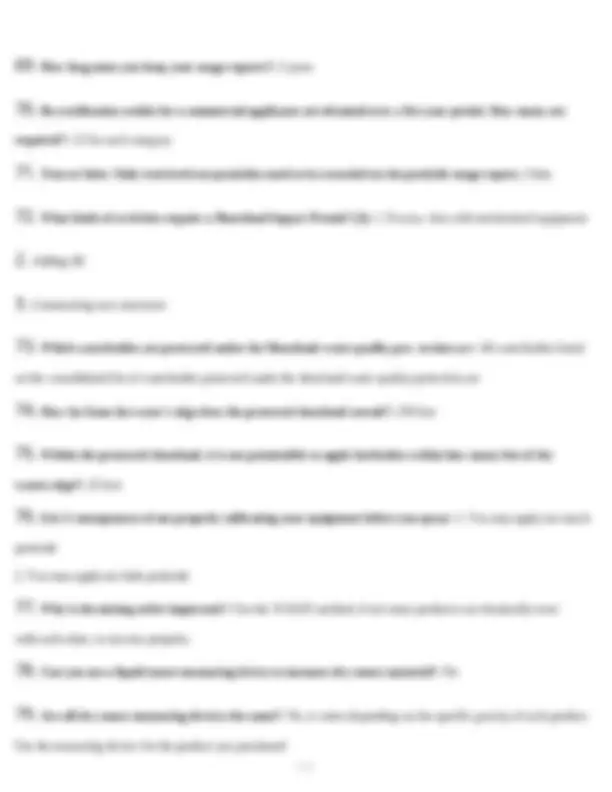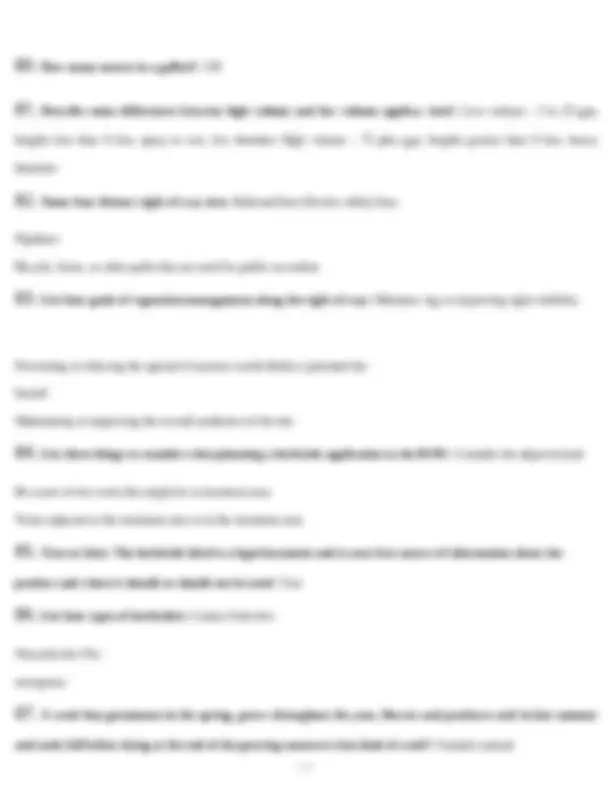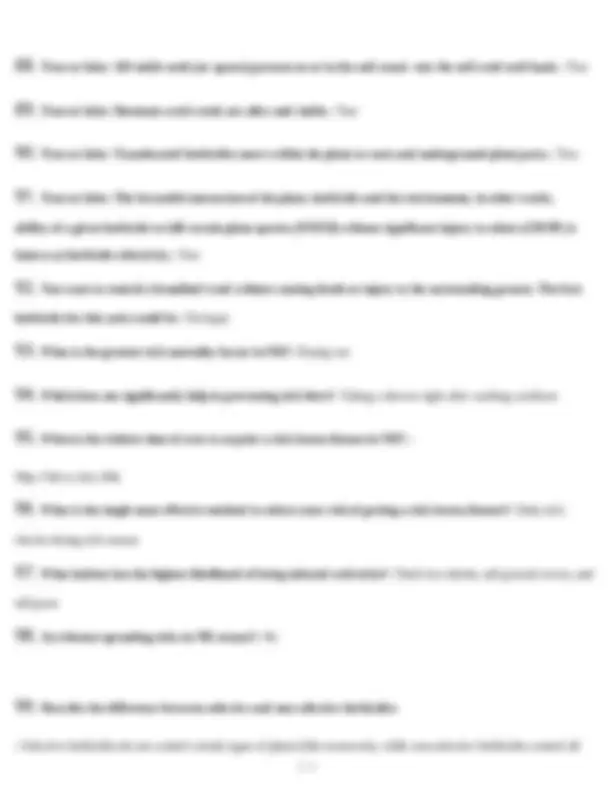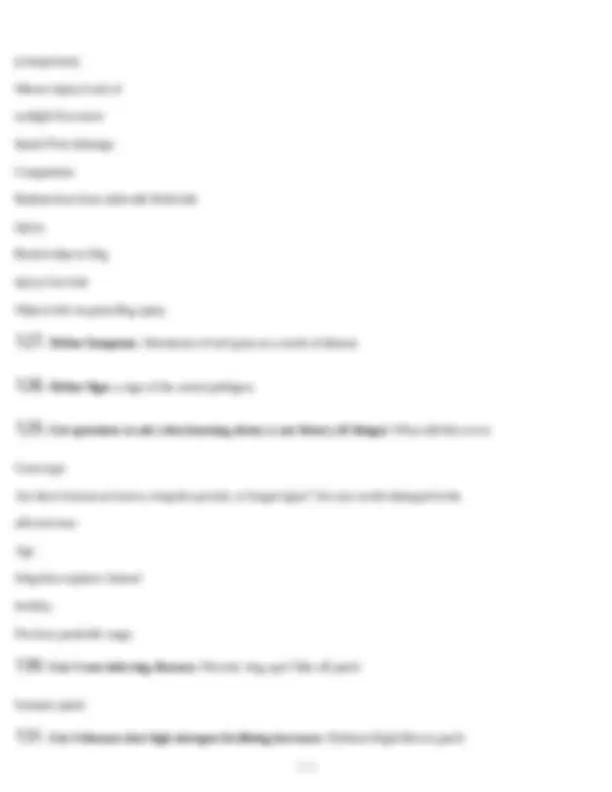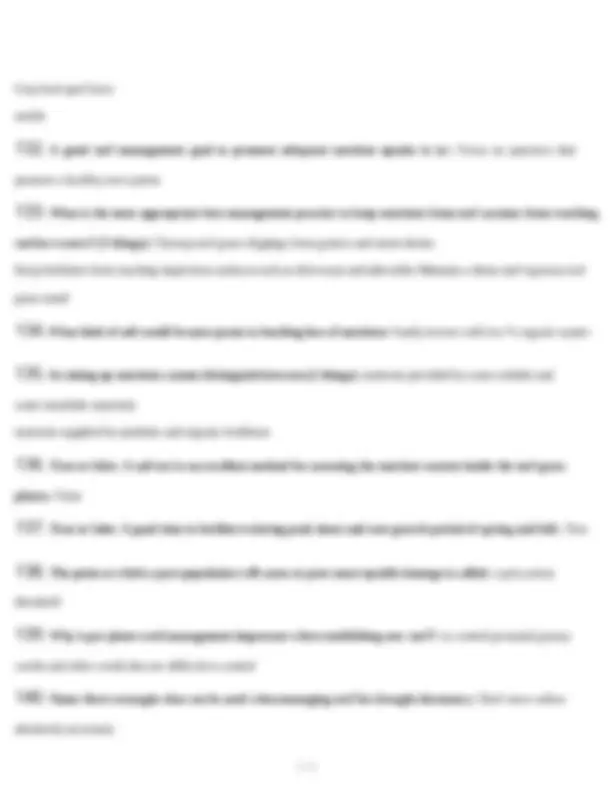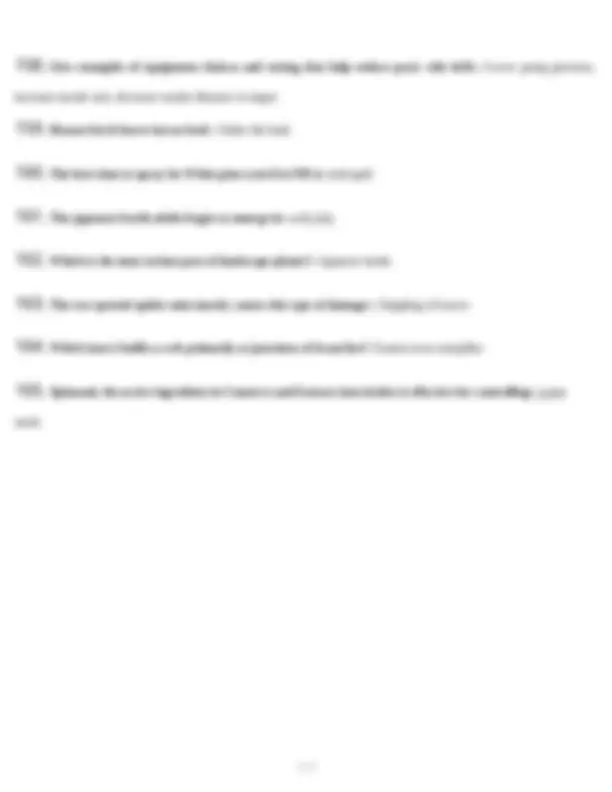Download NH Pesticide Study Guide with Complete Solution 100% and more Exams Biology in PDF only on Docsity!
NH Pesticide Study Guide with Complete Solution 100%
1. Where can you find the pesticide setback distances from wells and surface waters?:
http://www.agriculture.nh.gov/publications-forms/documents/set- back-brochure.pdf
2. Applying setback: Gravel Packed Public Well: 400 feet
3. Applying setback: Non Gravel Packed Public Well: 250 feet
4. Applying setback: Public Water Supply Within Watershed out to 5 miles: 250 feet
5. Applying setback: Public Waters: 50 feet
6. Applying setback: Non Public Waters: 25 feet
7. Mixing and Loading setback: Gravel Packed Public Well: 400 feet
8. Mixing and Loading setback: Non Gravel Packed Public Well: 250 feet
9. Mixing and Loading setback: All surface water: 75 feet
10. Mixing and Loading setback: All private water wells: 75 feet
11. Storage/dispensing setback: All public wells: 400 feet
12. Storage/dispensing setback: All private wells: 75 feet
13. Storage/dispensing setback: Surface water: 75 feet
14. Storage/dispensing setback: Public surface water supplies: 400 feet
15. Name the four classes of pesticides identified by New Hampshire regula- tions and identify the class that
cannot be used in New Hampshire: 1. General Use
2. Restricted Use
3. Prohibited-Limited Use
4. Prohibited (cannot be used in New Hampshire)
16. How often must a pesticide license be renewed?: Annually
17. When (what date) does a license expire if it is not renewed?: June 1st
18. How many years are there in a recertification cycle?: 5
19. How many credits are needed in a recertification cycle to maintain a commercial license?: 12 credits
multiplied by the number of categories licensed in
20. What is the definition of a "crew" in regard to the New Hampshire pesticide rules?: One or more men
working with one piece of mechanically powered equip- ment that has a capacity exceeding 3 gallons of liquid or 25 pounds of dry material; and those men working within speaking distance of one another and each applying pesticides by hand or each operating a piece of mechanically powered equipment that has a capacity of not more than 3 gallons of liquid or 25 pounds of dry material
21. What is the definition of a "special permit" in regard to the New Hampshire pesticide rules and in what
situation would a special permit be required?: a document issued by the division approving the use of pesticides in restricted areas including but not limited to application for mosquito control, aquatic nuisance control, aerial application, bird control, forest pest control, right of way pest control
22. Provide the NH pesticide rule definition of "drift": Drift means the airborne movement of pesticides resulting
4. Pesticides rarely work alone
30. True or False: IPM practices eliminate the need for pesticides: False
31. True or False: Mechanical incorporation into the soil during or after ap- plication, or by irrigation water
or rainfall following application, can reduce pesticide exposure to sunlight. This increases photo degradation.: False
32. Why would a grower want to practice IPM?: 1. Keep a balanced ecosystem
2. Save money
3. Promote a healthy environment
33. What is the economic injury level?: It is essentially the "break-even point" when the cost of control equals
the amount of damage
34. List some examples of cultural controls: 1. Appropriate fertilizers and rates based upon current soil tests
2. Plant spacing
3. Adjusting the time of planting
4. Selecting the right variety
5. Creating unfavorable conditions for the pest
35. Pesticide labels must be registered with what federal agency?: Environ- mental Protection Agency (EPA)
36. What is the significance of the EPA establishment number?: It identifies the actual facility where the product
was manufactured
37. Any pesticide that could cause death if one teaspoon or less is ingested will have which signal word on the
label, in addition to the skull and cross- bones symbol?: DANGER
38. True or false: Specific environmental precautionary statements may be present on the label describing
how to avoid run off or drift: True
39. True or false: A full and complete product label must be at the site of pesticide application: True
40. What are pesticide labels considered?: Legal documents
41. Hazard statements found on the pesticide label include which 3 things: 1. General environmental statements
2. Physical or chemical hazards
3. Flammability statements
42. True or false: Applying a pesticide to control a target pest not listed on the label is allowable and not
considered a violation of the label: True
43. If a label has the signal word warning, the toxicity level must be: moderately toxic
44. The signal word on a pesticide label indicates: degree of pesticide toxicity to humans
45. What is an adjuvant?: A chemical added to a pesticide mixture that helps the active ingredient do a better job.
Helps the pesticide stick to treated surface through possible bad weather.
46. What is the order in which materials should be added to a tank?: WALES
47. W in WALES: wettable powders/dry products
48. A in WALES: Agitate
4. Cleaning, adjusting or repairing equipment
60. What should you do to your washer after washing contaminated PPE?: af- ter washing the items, run the
washer through at least one additional entire cycle without clothing
61. Give examples of PPE (5 things): Headgear Footwear
Respiratory protection Apron Chemical resistant suit
62. Does natural rubber protect against liquid pesticides?: No. Natural rubber is only effective for dry
formulations
63. Should applicators who will be constantly exposed to small amounts of toxic pesticides for a day or several
days wear a respirator?: Yes
64. How often must daily use reports be filled out by pesticide applicators?-
: Every time a pesticide application is made. This could be more or less than once per day
65. True or false: Daily use reports must remain on file and accessible for at least 2 years, even if the company
is no longer in the business of applying pesticides/: True
66. True or false: Applicators must submit to the Department of Pesticide Control an itemized list of all
pesticide applications made in each calendar year.: False. A summary list of all pesticide products used and the area in which they were applied must be submitted each year for the period beginning November 1st and ending October 31st
67. True or false: Failure to submit annual use reports by the deadline will result in suspension of the
company's certification: True
68. When is the pesticide usage report due each year?: December 1st
69. How long must you keep your usage reports?: 2 years
70. Re-certification credits for a commercial applicator are obtained over a five year period. How many are
required?: 12 for each category
71. True or false: Only restricted use pesticides need to be recorded on the pesticide usage report.: False
72. What kinds of activities require a Shoreland Impact Permit? (3): 1. Excava- tion with mechanized equipment
2. Adding fill
3. Constructing new structures
73. Which waterbodies are protected under the Shoreland water quality pro- tection act: All waterbodies listed
on the consolidated list of waterbodies protected under the shoreland water quality protection act
74. How far from the water's edge does the protected shoreland extend?: 250 feet
75. Within the protected shoreland, it is not permissible to apply herbicides within how many feet of the
waters edge?: 25 feet
76. List 2 consequences of not properly calibrating your equipment before you spray: 1. You may apply too much
pesticide
- You may apply too little pesticide
77. Why is the mixing order important?: Use the WALES method, if not some products can chemically react
with each other, or not mix properly
78. Can you use a liquid ounce measuring device to measure dry ounce material?: No
79. Are all dry ounce measuring devices the same?: No, it varies depending on the specific gravity of each product.
Use the measuring device for the product you purchased.
88. True or false: All viable seeds (or spores) present on or in the soil consti- tute the soil weed seed bank.: True
89. True or false: Dormant weed weeds are alive and viable.: True
90. True or false: Translocated herbicides move within the plant to roots and underground plant parts.: True
91. True or false: The favorable interaction of the plant, herbicide and the environment, in other words,
ability of a given herbicide to kill certain plant species (WEED) without significant injury to others (CROP) is known as herbicide selectivity.: True
92. You want to control a broadleaf weed without causing death or injury to the surrounding grasses. The best
herbicide for this task would be: Triclopyr
93. What is the greatest tick mortality factor in NH?: Drying out
94. Which does not significantly help in preventing tick bites?: Taking a shower right after working outdoors
95. When is the riskiest time of year to acquire a tick-borne disease in NH?: -
May 15th to July 10th
96. What is the single most effective method to reduce your risk of getting a tick-borne disease?: Daily tick
checks during tick season
97. What habitat has the highest likelihood of being infested with ticks?: Thick low shrubs, tall ground covers, and
tall grass
98. Are disease spreading ticks in NH ornate?: No
99. Describe the difference between selective and non-selective herbicides-
: Selective herbicides do not control certain types of plants (like monocots), while non-selective herbicides control all
plants.
100. Describe the difference between residual and non-residual.: Residual pes- ticides will remain in the soil to
continue to control pests, while non-residual pesti- cides have no lasting effect once initially applied.
101. Describe some differences between High Volume and Low Volume appli- cation.: Low: 5-25 gpa, heights
less than 6 feet, spray to wet, low densities High: 75 plus gpa, heights greater than 6 feet, heavy densities
102. List the components of IPM Understanding the system and pest (4 things): Establish economic or
aesthetic thresholds Monitor the pest When needed, select the appropriate control strategy, or strategies Evaluate your results
103. List at least 5 factors that can affect drift (8 total): Type of pesticide formu- lation
Droplet size Droplet release height Nozzle type Wind Temperature Nozzle orientation Spray additive used
104. Does drift potential increase or decrease with Increased nozzle pres- sure?: Increase
105. The number one factor that influences spray drift is?: Droplet size
106. What is volatility?: The potential for spray droplets to go from liquid to vapor particles. Pesticide formulation
has a large effect on volatility, as does temperature and humidity. High temperature and low humidity = higher risk of volatility
107. True or false: Temperature inversions are the best time to spray because of no wind to move the spray
generally more damaging than native in- sects?: Because introduced pest species do not have the complement of parasites and predators that keep the insect population in check in its native range.
119. How would you identify a grub to species?: By looking at the raster pattern with a 10x or 20x hand lens.
120. List all of the factors that may result in the failures of white grub control. (4 things): Lack of sufficient post-
treatment irrigation Over-irrigation Too much thatch Runoff of chemical applications on sloped turf grass areas
121. What are some of the things you can do to prevent harming bees?: Do not spray any flowering plants. If the
turf to be treated has clover, mow before applying any insecticide (especially sprays). Use the least-toxic chemicals to bees.
122. Which systemic insecticide is considered to have the lowest toxicity to bees?: Acelepryn.
123. Explain the difference between curative and preventative turf grass insect control.: Curative control is
making an application when turf grass insects reach a threshold population level. Preventative applications are generally made before the target insect is present but may be based on a history of infestation
124. True or false: There are kentucky bluegrass cultivars that are resistant to billbug feeding.: True
125. What are the three components of the disease triangle?: Favorable envi- ronment
Virulent pathogen Susceptible host
126. List as many sources of abiotic injury to turf grass as possible (17 things): Summer dormancy
Fertility Fertilizer burn Too little or too much watering Traffic
(compaction) Mower injury Lack of sunlight Excessive thatch Poor drainage Competition Radiant heat from sidewalk Herbicide injury Buried objects Dog injury Gas leak Objects left on grass Bug spray
127. Define Symptom: Alterations of turf grass as a result of disease
128. Define Sign: a sign of the actual pathogen
129. List questions to ask when learning about a case history (8 things): When did this occur
Grass type Are there lesions on leaves, irregular growth, or fungal signs? Are any weeds damaged in the affected area Age Irrigation regimen Annual fertility Previous pesticide usage
130. List 3 root infecting diseases: Necrotic ring spot Take-all patch
Summer patch
131. List 4 diseases that high nitrogen fertilizing increases: Pythium blight Brown patch
Inspect for pest infestation Restrict traffic Fertilize when growth resumes Plan to overseed damaged areas
141. Name 5 cultural management strategies that can help reduce damage from insects.: Select grasses for
site and use Choose endophytic grasses Encourage rooting Reduce drought, heat, and other abiotic stresses Manage thatch
142. Name 7 cultural management strategies that can help reduce damage from disease infestations: Avoid
moisture stress Do no prolong leaf wetness Manage pH and fertility Adjust mowing practices Use resistant or endophytic turf grass cultivars Relieve compaction Provide adequate drainage
143. True or false: All cool season turgrasses show the same degree of toler- ance to environmental stresses such
as heat and drought.: False
144. True or false: A chemical with a Danger label always has a higher risk associated with it than one with
a Caution label.: False
145. Soil injection is often a way of applying pesticides that is likely to cause less off site contamination. When is
this most likely to not be true?: Sloped terrain, waterlogged soil, sandy soil, and shallow ledge.
146. True or false: You should use a rate below the recommended label rate of a pesticide when drift or runoff
is a concern.: False
147. What can help reduce drift?: Low pressure high volume and incorporating an adjuvant in the mixture.
148. Updraft can be a problem when:: The air aloft is cooler than the surface air.
149. True or false: Any chemical can be used as a basal trunk spray using the 2ee exemption if drift is a
concern.: False
150. True or false: If a pesticide is organic, I can be less concerned about drift as organic pesticides are always
safe to use.: False.
151. You may need to choose a broad spectrum, long residual pesticide when:-
: You need to control a specific pest in a spot or limited application.
152. True or false: Spinosad is a good choice for controlling Sawfly as it is
a low risk, bio rational chemical that achieves good control of caterpillars.: - False.
153. True or false: The neonicatanoids are effective for controlling many scale insects as a soil drench or basal
trunk application. Imidacloprid would always be a better choice than acetamiprid as it lasts longer in the plant and will give me a longer window of control.: False
154. What spray equipment criteria is most important to improve penetration of heavy vegetation and reach
the tops of tall shade trees?: Sprayer nozzle selection
155. A pre-emergent herbicide label states that crabgrass is controlled when snapshot 2g is applied at the rate
of 2.3 lbs for 1000 square feet. How much snapshot should be applied to treat 1/4 acre.: 25
156. Which activities require a back flow protection device for safety: Hose-end spraying and filling tanks.
157. Describe how to deal with nozzles that are producing an irregular spray pattern.: Check pressure. Clean
strainers. Clean nozzles.

